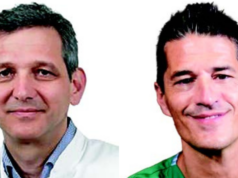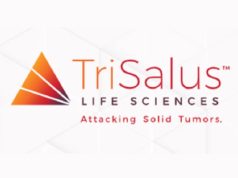 This article is sponsored by Terumo Interventional Systems.
This article is sponsored by Terumo Interventional Systems.
Holmium-166 (166Ho) radioembolization is a safe treatment option for patients with hepatocellular carcinoma (HCC), show results from the prospective, clinical phase I/II HEPAR Primary study, presented at the European Conference on Interventional Oncology (ECIO; 10–13 April, online). Interventional News speaks with Marnix Lam (University Medical Centre Utrecht, Utrecht, The Netherlands) about these latest data, which are anticipated to be published in the coming months, as well as what to expect from the iHEPAR study, which looks at a fully individualised treatment approach, and which Lam claims is the future of HCC treatment.
In the HEPAR Primary study, the investigators set out to establish the toxicity profile of 166Ho radioembolization (average liver absorbed dose of 60Gy) in patients with HCC. The primary endpoint was the rate of unacceptable toxicity, defined as total bilirubin increase grade 3 or higher (common terminology criteria for adverse events; CTCAE v.4.03) in combination with ascites and low albumin (radioembolization-induced liver disease; REILD), or any serious adverse event that was related to study treatment. Secondary endpoints included efficacy (according to modified response evaluation criteria in solid tumours; mRECIST), alpha fetoprotein response, dosimetry, quality of life, and liver function. Clinical and laboratory follow-up took place at three and six weeks, and three and six months. Patients included had measurable and liver-dominant disease and no curative treatment options.
Of the 31 patients included in the study, 71% were Barcelona Clinic Liver Cancer (BCLC) stage B, and 29% were BCLC stage C. Most (87%) had multifocal disease, and the median diameter of the largest tumour was 56mm (range 15–195mm). Lam describes this patient cohort as a “real-world” population.
Unacceptable toxicity related to the study treatment occurred in three patients; no REILD was encountered. New or worsened toxicity observed were: fatigue (71%), back pain (55%), ascites (32%), dyspnoea (23%), nausea (23%), and abdominal pain (23%), mostly grade 1. At three- and six- months follow-up, 54% and 84% of the target liver lesions showed complete or partial response. Median overall survival was 14.9 months, and no significant decline in quality of life was observed.
What do the HEPAR Primary study results tell us in terms of the safety and efficacy of the procedure?
Most importantly, the primary endpoint of the HEPAR Primary study was safety. It was a Phase I/II study, in which safety was the primary endpoint and efficacy a secondary endpoint. From the study, we concluded that the toxicity is acceptable. We had pre-defined safety limits: in short, we considered grade III or higher toxicity, which was related to treatment, as unacceptable—but we only found this rate in three out of 31 patients, which confirms the safety in this patient population This result gives us the confidence to move on to further clinical studies of 166Ho-radioembolization in HCC patients.
The efficacy results of the HEPAR Primary study are also very encouraging, both in terms of response rate and in terms of survival for this patient population. This inspires us to continue to investigate this treatment for HCC patients.
I think what is very important for the HEPAR Primary study is the treatment planning involved. We chose an average absorbed dose for the whole perfused volume, so we did not make the differentiation between how many of these microspheres go to the tumour, and how many go to the surrounding liver tissue. For example: in one patient, the microspheres may all end up in the tumour, and none in the surrounding liver tissue (which is ideal, of course, because you hit the tumour hard and you do not damage the surrounding liver), but in another patient, it may be the other way around—you damage the surrounding liver tissue and you do not hit the tumour. So if you choose an average dose, and you treat all patients with a similar number of microspheres and just see where they end up, you are utilising a one-way-fits-all approach. Considering that we used this very rough treatment planning technique, I think the results are even more encouraging, with a lot of room for further improvement.
For every patient, after treatment, we can see the dose that went to the tumour and to the liver, and therefore we can ascertain how that correlates to effect and toxicity. We expect that the harder we hit the tumour, the better the effect, and the same for toxicity. So if we know that correlation, we can say, ‘OK, in terms of safety, the surrounding liver tissue can tolerate this amount of dose as a maximum’, and then in the next study, we will use that for individualised treatment planning.
Why is it important to have these prospective data?
These data are important to establish the safety profile of 166Ho-radioembolization. The HEPAR Primary study is the start of where we want to go with this therapy.
I think it is important to understand that previous studies on radioembolization in HCC—large, Phase III studies—all failed. These particular studies did not use individualised treatment. Because of that, the majority of patients were under-dosed. If you are treating blindly, then of course you need to be careful. I think for us now, it is incredibly important to show that the technique works.
How does the Holmium Platform enable treatment individualisation, and what does the future of HCC treatment look like?
The HEPAR Primary study is really the first step. The second step is showing that individualised radioembolization is feasible and has a benefit. The third step will be to compare it to the standard of care. That is also important—to show that this treatment option has a role to play in the HCC treatment algorithm.
To this end, we are currently working on the iHEPAR (individualised HEPAR) study. In this study, we are using a scout dose as part of the entire Holmium Platform to further individualise the selective internal radiation therapy (SIRT) planning. We have two procedures: the first procedure involves using a limited number of microspheres—enough to visualise where we are going, but not enough to cause damage. That is the scout procedure. We use a scout dose for three reasons:
- To determine where exactly the microspheres are going (for example, are they just in the tumour, are some reaching the surrounding healthy liver tissue, or is there a leak to the stomach or elsewhere? We want to avoid that)
- To see if the microspheres are remaining in the liver—we want to avoid lung shunting, for example
- To understand the distribution within the liver—how many microspheres end up in the tumour, and how many end up in the normal liver?
In the HEPAR Primary study, we did use 166Ho scout dose, but it wasn’t applied to perform dedicated treatment planning. As a result, we treated patients with a one-size-fits-all approach. We used this information to establish the dose-effect relationship, which allowed us to determine the safety threshold dose for the liver. In the iHEPAR study, we will start using the information we obtain from the 166Ho scout dose to personalise the treatment using the entire end-to-end Holmium Platform. For example, if there is a patient where all the microspheres end up in the tumour, we can give him a higher dose.
Another area of future work is investigating the potential of combining 166Ho radioembolization with immunotherapy.
Especially in the era of immunotherapy, combining a locoregional treatment with an immunotherapy treatment is, I think, very interesting. To me, that seems to be the most logical next step: there are already studies underway that combine transarterial chemoembolization (TACE) with immunotherapy, so it seems logical to start combining radioembolization with immunotherapy.
I think that the best candidates for radioembolization are patients with large tumours. Usually, the larger the tumours, the greater the vasculature, so the better they absorb the microspheres, so to speak. This means you are able to target the tumour without damaging the surrounding tissue. So if, for example, you were treating a patient with a very large tumour on the right side of the liver, and multiple small ones on the left, this would be a super interesting candidate for combination therapy. You could hit the big tumour on the right side with 166Ho radioembolization, and then treat the smaller ones with systemic therapy (e.g. immunotherapy).













